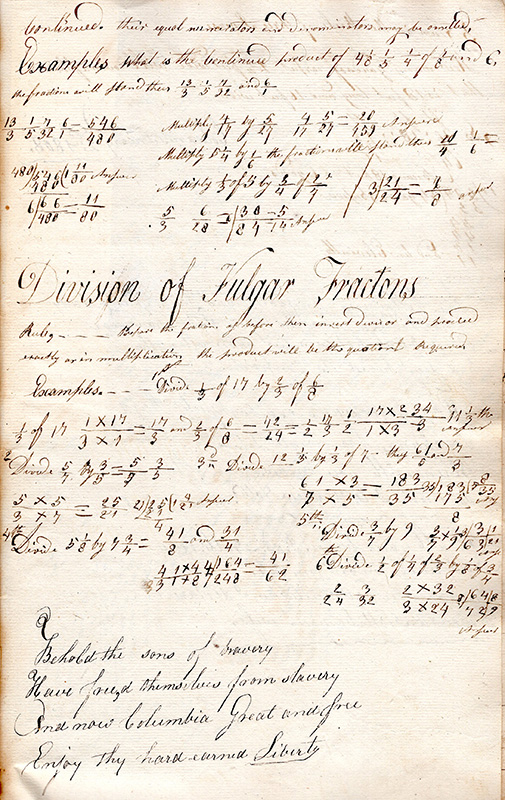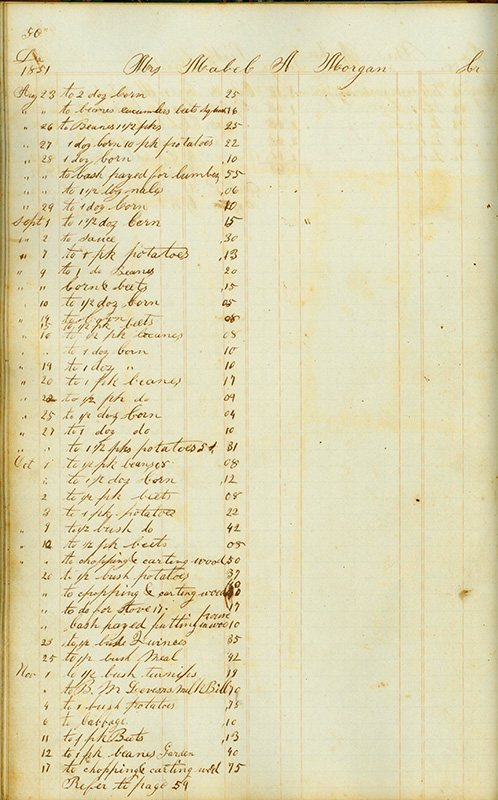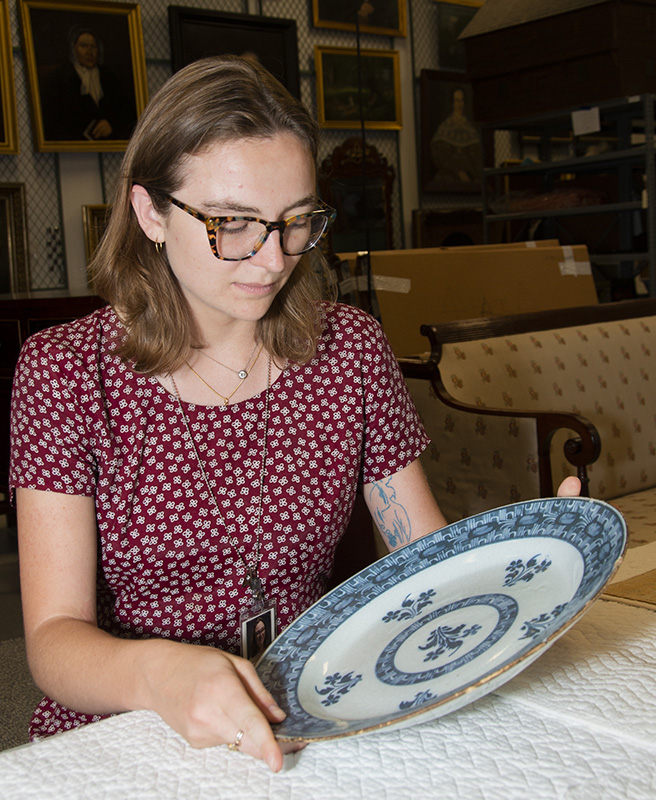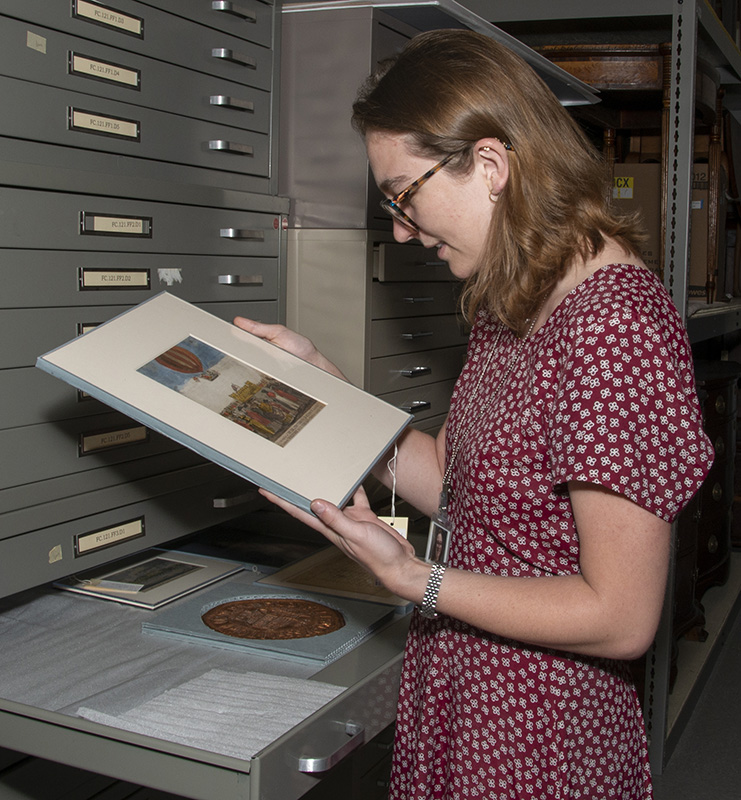More Than Meets the Eye: Cyphering Books at Historic Deerfield
by Mary Orms
Aside from countless new friends, my experience as a Summer Fellow at Historic Deerfield has left me with an invaluable sense of direction as I begin my career in the museum field.
Thanks to a continuing education scholarship from the Decorative Arts Trust, I spent the summer in the museum setting, working closely with early American material culture. I focused my research on cyphering books, a subset of the copybook tradition created by young students. Cyphering books are manuscripts created by students for the purpose of learning arithmetic, algebra, navigation, geometry, or a number of other mathematical subjects. These folio-sized books are typically rectangular and sometimes have protective covers made of leather or stiff paper.
The cyphering tradition was transplanted from England to the American colonies and adapted over time. Although these works are characterized by conformity and consistency, they are also notably personal. American cyphering books from the period in between the Revolution and the Civil War offer insight into the construction of American national identity by uncovering the values and capabilities that adults sought to instill in the younger generation.
Historic Deerfield’s special collection includes a cyphering book by Amos Bardwell. Created 1805–08, the large, leather-bound volume explores a breadth of topics beginning with “Simple Addition” and building in complexity to end with the “Rule of Three Inverse.” While its content range is extensive, the book lacks specialization in a particular field. Bardwell’s book is interesting in its inclusion of personal anecdotes, practice signatures, poems, and artistic additions. Bardwell’s non-mathematical marginalia include repeated images and motifs which provide insights into his desire for individuality and personalization among a practice so grounded in uniformity and consistency.
The Sheldon Family Papers, a collection held at the Pocumtuck Valley Memorial Association (PVMA) Library in Deerfield, features an 1824–28 cyphering book created by Ms. Arabella Sheldon. A single volume lined with decorative paper, the book is neatly organized and displays the highest amount of proficiency in penmanship of the three cyphering books I analyzed. The book also demonstrates Ms. Sheldon’s mastery of multiple fonts and designs, and a certain delight in the exhibition of those skills. Aside from aesthetic and design, the Sheldon cyphering book is indicative of the gendered and otherwise metered access to mathematics education in the early American school system. Topically, the book ranges from “Simple Addition” to “Extraction of the Square Root” and includes a section devoted to calculating interest (complete with a discussion of “Compound Interest”).
Jabez Bushnell’s two-volume c. 1844 cyphering book is housed in Historic Deerfield’s special collection. One begins with “Addition of Fractions” and ends with a discussion of “Proportions.” The other begins with the “Rule of Three Direct” and ends with an incomplete section titled, “Extraction of the Cube Root.” This set of cyphering texts is slightly unusual in that it begins from an intermediate level of mathematics proficiency. Whereas the other two books start with “Simple Addition” and other mathematics fundamentals (sometimes referred to as “the four functions”), Bushnell starts midstream and continues toward a highly technical end. Bushnell was likely the oldest cyphering student of the three. His books are full of applications of mathematics concepts to the world of business and commerce, including sections titled “Commission,” “Fellowship,” “Insurance,” “Annuity,” and others. Bushnell’s books also contain personal (non-mathematical) additions such as signatures and poems. Also tucked into his account book were two loose papers: one receipt and one debt notice. These loose pages may confirm that Bushnell did in fact refer to his cyphering book later in life. The Historic Deerfield special collection also contains one of Mr. Bushnell’s account books, kept from 1847 to 1853. Though this account book would have been one of many, it strongly suggests that Bushnell took up a career as a merchant and/or shop owner, a career for which mathematical proficiency was vital.
These three cyphering books paint a picture of the educational environment following the American Revolution. They offer insight into the educational and societal ideals of the early nation and illustrate the desire for financial literacy and independence for the next generation. Although all three sources are from New England, they can be taken as representatives of the larger American cyphering tradition.
With one year left in my undergraduate studies, the Historic Deerfield Summer Fellowship program has enriched my life as an academic, a historian, and a life-long learner. The Fellows became great friends over the summer, but we also pushed each other to question our ideas. We helped each other brainstorm, research, and edit; each of us is better for our summer in Deerfield, and I am grateful for the Trust’s support of this opportunity.
Mary Orms is a senior, majoring in Honors History and Religious Studies at the University of Texas at Austin. Presently, she is writing an honors thesis on the saddles of the early King Ranch as evidence of Mexican and Anglo-American contributions to modern cattle ranching practices in Texas.
About The Decorative Arts Trust Bulletin
Formerly known as the "blog,” the Bulletin features new research and scholarship, travelogues, book reviews, and museum and gallery exhibitions. The Bulletin complements The Magazine of the Decorative Arts Trust, our biannual members publication.
Click Images to Enlarge
Did you know that clicking on the images in Bulletin posts will allow you to get a closer look? Simply click on an image, and a larger version will open in a pop-up window.













